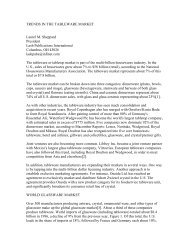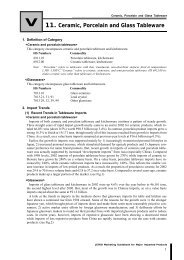Appendices to CBI Export Planner - crecer
Appendices to CBI Export Planner - crecer
Appendices to CBI Export Planner - crecer
You also want an ePaper? Increase the reach of your titles
YUMPU automatically turns print PDFs into web optimized ePapers that Google loves.
<strong>CBI</strong> <strong>Export</strong> <strong>Planner</strong>The Cost-Plus method is not suited as an instrument for export-marketing, because youcan not influence the cus<strong>to</strong>mer <strong>to</strong> buy your product and you depend <strong>to</strong>o much uponothers (e.g. the importer). It is better <strong>to</strong> find out yourself what the cus<strong>to</strong>mer is willing <strong>to</strong>pay for your product. It is an important buying motive as it represents the sacrifice(paying money) he/she is willing <strong>to</strong> make in order <strong>to</strong> obtain satisfaction (the function ofthe product).All cus<strong>to</strong>mers constantly make buying decisions, comparing the sacrifice with theexpected satisfaction. He/she compares prices of competitive products (e.g. differentkinds of bread), but also their different qualities (which product brand gives best value).Thirdly, the cus<strong>to</strong>mer compares products that can substitute each other (e.g. rice andbread). The main criterion used is price.Setting the price<strong>Export</strong>ers from developing countries will usually be price-followers, not price-setters.Their products will rarely be so unique in the target markets, that they can actuallydictate the price-level in that market.When supplying <strong>to</strong> other manufacturers - as two-thirds of all SME exporters do - thebuyers usually dictate the price at which they are allowed <strong>to</strong> sell. ‘Produce this at theprice of $ 2.- a piece, or else I will go <strong>to</strong> the competition’. In such cases you better dowhat the buyer asks and try <strong>to</strong> find your USP in another instrument of the marketing mix.In delivery reliability, for instance, since that asset weighs heavily on the buyer’sconscience.For price-followers the pricing decisions <strong>to</strong> be taken by management are:1 establish the current market pricing for comparative and/or substitutive products inthe target market,2 establish all the elements of the market price, like VAT, margins for the trade and theimporter, import duties, freight and insurance costs etc.,3 make a <strong>to</strong>p-down calculation, deducting all the elements of the expected market priceof your product(s) in order <strong>to</strong> arrive at the price “Ex Works” (traditionally called “ExFac<strong>to</strong>ry”) or ex warehouse,4 see if you can meet this price;5 if not, re-calculate your own cost price by finding ways <strong>to</strong> decrease costs in your ownfac<strong>to</strong>ry or organisation. Or decrease your marketing budget, which also burdens yourexport-market price.6 Estimate <strong>to</strong>tal sales over a three-years period, add <strong>to</strong>tal planned expenses, includingthose of your export department, travelling and canvassing efforts;7 make a bot<strong>to</strong>m-up calculation per product item, dividing the supporting budgets overthe <strong>to</strong>tal number of items <strong>to</strong> be sold,8 set the final market prices;9 test the price (through market research).Nine steps <strong>to</strong> set your final price in the market. It will prove a lengthy and difficultprocess, but it is an essential one. Therefore, this book will give you three examples, allusing the same hypothetical cost data:1. a “<strong>to</strong>p-down” calculation, enabling you <strong>to</strong> establish if you can meet your competi<strong>to</strong>rs’market-prices at cost-price level,2. a “bot<strong>to</strong>m-up” calculation <strong>to</strong> help you setting your final price in the target market.38 III - The export marketing mix





